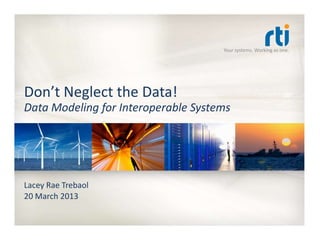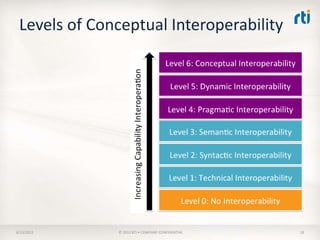Don’t Neglect the Data! Data Modeling for Interoperable Systems.
- 1. Your systems. Working as one. Don’t Neglect the Data! Data Modeling for Interoperable Systems Lacey Rae Trebaol 20 March 2013
- 2. Context
- 3. Topics • Systems, Integration, and Interoperability • Data Modeling for Interoperable Systems • RTI Products and Services • Q&A
- 4. Systems
- 5. Systems
- 6. Systems
- 7. Systems
- 8. Integration The process of linking together different computing systems and software applications physically or functionally, to act as a coordinated whole.
- 9. Integration
- 10. Integratability Integratability is the ability for some combination of systems to come together and form, coordinate, or blend into a functioning or unified whole.
- 11. Interoperation The setup of components and methods to make two or more systems work together as a combined system.
- 12. Interoperation
- 13. Interoperation
- 14. System of Systems A system of systems is a collection of task-oriented or dedicated systems that pool their resources and capabilities together to create a new, more complex system which offers more functionality and performance than simply the sum of the constituent systems.
- 15. Interoperability Interoperability is the ability for systems, units, or forces to provide services to and accept services from other systems, units, or forces, and to use the services so exchanged to enable them to operate effectively together.
- 16. Levels of Conceptual Interoperability
- 17. Technical Interoperability ‚Ä¢ Requires ‚Äì Communications Infrastructure established ‚Ä¢ Result ‚Äì Bits & Bytes are exchanged in an unambiguous manner ‚Ä¢ Non-Functional Need Met ‚Äì Replaceability ÔÉÝ Interchangeability –¥–æ–±—Ä–æ–µ —É—Ç—Ä–æ „Åä„ÅØ„Çà „ÅÜ
- 18. Syntactic Interoperability • Requires – Communications Infrastructure established – Common structure or common data format for exchanging information • Result – Bits/Bytes and the Structure of Data are exchanged in an unambiguous manner • Non-Functional Need Met – Interchangeability and Integratability What was her temperature? 37.2 Get the warming blankets.
- 19. Semantic Interoperability • Required – Communications Infrastructure and Common Data Format are established – Common information model is defined for exchanging the meaning of information • Result – Bits/Bytes and the structure of data are exchanged in an unambiguous manner – Content of the information exchanged is unambiguously defined • Non-Functional Need Met – Actual, high-level Interoperability The apple is orange and yellow. What does that have to do with her surgery? Oh! I thought we were talking about food. She didn’t need surgery.
- 20. Data Modeling for Interoperable Systems
- 21. Model A model is anything used in any way to represent something else
- 22. Data Model A data model is a representation that describes the data about the things that exist in your domain
- 23. Systems of Systems are Different System of Systems [n] types of systems [n]sets of requirements + the requirement for Semantic Interoperability many things to express many different representations of those expressions to achieve interoperability
- 24. The SOS Data Model Shall… 1. Meet the requirements of all of the constituent systems 2. Support the overarching requirement for Semantic Interoperability 3. Allow for changes to be made to the model without requiring changes to the existing system and application interfaces that use it Formal Language Rigorous Documentation Formal Process 1. 2. 3. We Need A Formal Approach!
- 25. Formal Language for Data Modeling • Similar to structured, rigoro us programming languages • Ambiguity is not acceptable – Syntax – Semantics Formal Language Alphabet Transformation Rules Formation Rules
- 26. Semantics, Ambiguity, and Language Natural Language Representation • A pair of shoes that Claire wants costs 1500 dollars. She waits until the shoes go on sale. She can spend 450 dollars, including 8.25% tax. On Monday, the shoe store discounts everything by 50%. Each day an item is not sold, it is discounted another 25%. How soon can Claire buy her shoes? Formal Language Representation Pc = $1500... Pc = $1500´ 1+ 0.0825( ) or $1500 ì í ïï î ï ï = $1,623.75 or $1,500.00 t = tbuywhen P £ $450 @t =1, P = Pc ´ 1- 0.5( ) ì í ï î ï = $811.88 or $750.00 @t ³ 2, P = Pc ´ 1- 0.5( )éë ùû´ t -1( )´ 0.75éë ùû ì í ï î ï =...
- 27. Documentation Methodology • Documenting only your messages is insufficient • Documentation doesn’t end at the data model – Your system – Key decisions – Context
- 28. Formal Process • Mandates are insufficient with so many stakeholders • Can’t dictate everything, must accommodate many things • SOS DM needs to enforce rigorous well defined processes, not mandate messages Atomic Elements Elements of Meaning
- 29. Putting the Pieces Together Things to Model from System A Data Model Data Modeling Process Structure Behavior Context representation A representation A representation [n] per a Rigorous and Formal Approach
- 30. Data Centric Integration Solution Legacy System A Mediation Future System C Mediation New System B Mediation • Technical Interoperability – Infrastructure & Protocol • Syntactic Interoperability – Common Data Structure • Semantic Interoperability – Common Data Definition
- 31. RTI Products and Services
- 32. RTI’s Data Centric Integration Solution Connext DDS Professional DDS-RTPS Wire Interoperability Messaging Real-Time Apps Disparate Apps/Systems Integrator Tools Administration Monitoring Recording Replay LoggingSystem Viz • Connext DDS – Wire Interoperability – Xtypes • Connext Integrator – Mediation • Future Evolutions – More powerful – More flexible – More systems. Working as 1.
- 33. Q&A
- 34. Your systems. Working as one. Download Connext Free Trial NOW www.rti.com/downloads























![Systems of Systems are Different
System
of
Systems
[n] types of
systems
[n]sets of
requirements +
the requirement
for Semantic
Interoperability
many things to
express
many different
representations of
those expressions
to achieve
interoperability](https://image.slidesharecdn.com/allaboutthedatasubmitss-130613154637-phpapp01/85/Don-t-Neglect-the-Data-Data-Modeling-for-Interoperable-Systems-23-320.jpg)





![Putting the Pieces Together
Things to
Model from
System A
Data Model
Data Modeling Process
Structure
Behavior
Context
representation
A
representation
A
representation
[n]
per a
Rigorous and Formal
Approach](https://image.slidesharecdn.com/allaboutthedatasubmitss-130613154637-phpapp01/85/Don-t-Neglect-the-Data-Data-Modeling-for-Interoperable-Systems-29-320.jpg)




